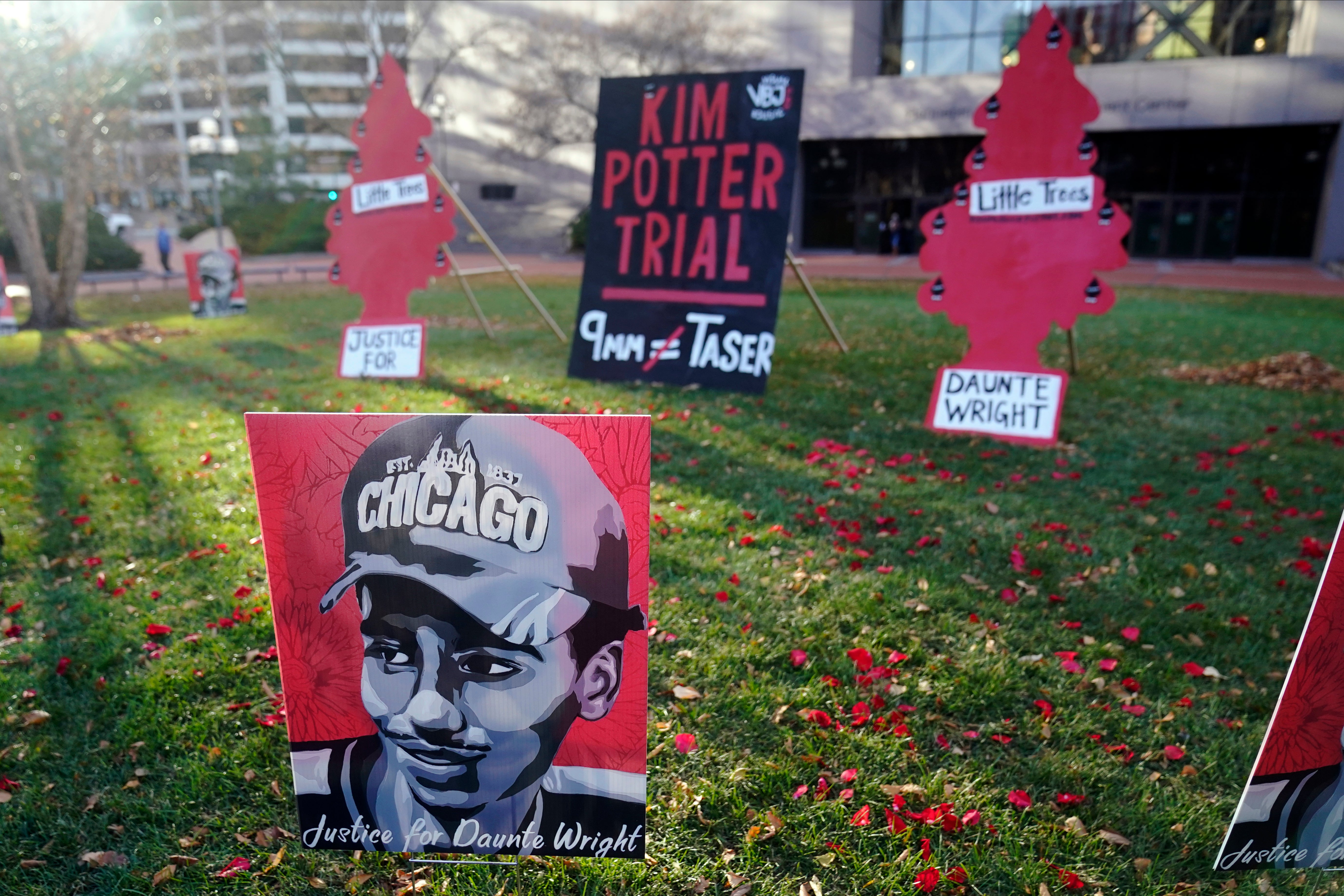EXPLAINER: How does an officer use a gun instead of a Taser?
At former Minnesota police officer Kim Potter’s manslaughter trial for fatally shooting Daunte Wright, a Black motorist, the core of her defense is clear: She says she meant to use her Taser but grabbed her handgun instead

Your support helps us to tell the story
From reproductive rights to climate change to Big Tech, The Independent is on the ground when the story is developing. Whether it's investigating the financials of Elon Musk's pro-Trump PAC or producing our latest documentary, 'The A Word', which shines a light on the American women fighting for reproductive rights, we know how important it is to parse out the facts from the messaging.
At such a critical moment in US history, we need reporters on the ground. Your donation allows us to keep sending journalists to speak to both sides of the story.
The Independent is trusted by Americans across the entire political spectrum. And unlike many other quality news outlets, we choose not to lock Americans out of our reporting and analysis with paywalls. We believe quality journalism should be available to everyone, paid for by those who can afford it.
Your support makes all the difference.At former Minnesota police officer Kim Potter’s manslaughter trial for fatally shooting Daunte Wright a Black motorist, the core of her defense is clear: She says she meant to use her Taser but grabbed her handgun instead.
Potter’s body-camera video recorded the shooting, with Potter heard saying, “Taser, Taser, Taser” before she fired, followed by, “I grabbed the wrong (expletive) gun.”
Many activists have refused to accept the former Brooklyn Center officer’s explanation and the state has argued that Potter — a 26-year police veteran — had the experience and training to know better.
Taser-gun mix-ups are rare but they have happened in several states in recent years.
Here are some questions and answers about such incidents:
HOW FREQUENTLY DOES THIS HAPPEN?
Experts agree that such incidents are rare and probably happen fewer than once per year throughout the U.S. A 2012 article published in the monthly law journal Americans for Effective Law Enforcement documented nine cases dating back to 2001 in which officers shot suspects with handguns when they said they meant to fire stun guns.
WHY DOES IT HAPPEN?
Reasons that have been cited include officer training, the way they carry their weapons, and the pressure they feel during dangerous and chaotic situations. To avoid confusion, officers typically carry their stun guns on their weak sides — the side of their nondominant hand — and away from handguns that are carried on their dominant hand’s side. That’s how Potter carried hers, and the chief of her suburban Minneapolis police department at the time of the shooting said that’s how the department’s officers were trained.
Bill Lewinski, an expert on police psychology and the founder of the Force Science Institute in Mankato, Minnesota, has used the phrase “slip and capture” errors to describe the phenomenon.
Lewinski, who has testified on behalf of police, has said officers sometimes perform the direct opposite of their intended actions under stress — that their actions “slip” and are “captured” by a stronger response. He notes that officers train far more often on drawing and firing their handguns than they do on using their stun guns.
Potter’s defense team has an expert lined up to testify about “slip and capture.”
Other experts are skeptical of the theory.
“There’s no science behind it,” said Geoffrey Alpert, a criminology professor at the University of South Carolina and an expert on police use of force. “It’s a good theory, but we have no idea if it’s accurate.”
Alpert said a major factor in why officers mistakenly draw their firearm is that stun guns typically look and feel like a firearm.
WHAT ARE SOME OTHER CASES?
In one of the best-known cases, a transit officer responding to a fight at a train station in Oakland, California, killed 22-year-old Oscar Grant in 2009. The officer, Johannes Mehserle, testified at trial that, fearing Grant had a weapon, he reached for his stun gun but mistakenly pulled his .40-caliber handgun instead. Grant was shot as he lay face down.
Mehserle was convicted of involuntary manslaughter and sentenced to two years in prison. His department paid $2.8 million to Grant’s daughter and her mother.
In Tulsa, Oklahoma, a white volunteer sheriff’s deputy, Robert Bates, said he accidentally fired his handgun when he meant to deploy his stun gun on an unarmed Black man, Eric Harris who was being held down by other officers in 2015.
Bates apologized for killing Harris but described his deadly mistake as a common problem in law enforcement, saying “This has happened a number of times around the country... You must believe me, it can happen to anyone.”
Bates was convicted of second-degree manslaughter and sentenced to four years in prison. Tulsa County ultimately agreed to pay $6 million to Harris’ estate to settle a federal civil rights lawsuit.
In 2019, a suburban St. Louis police officer, Julia Crews, said she meant to use her stun gun but mistakenly grabbed her service revolver and shot a suspected shoplifter, Ashley Hall, who suffered serious injuries. Crews resigned and was charged with second-degree assault. That was eventually dropped at Hall’s request after the victim and the former officer agreed to participate in restorative justice mediation. Separately, the city of Ladue agreed to a $2 million settlement with Hall.
___
Find the AP’s full coverage of the Daunte Wright case: https://apnews.com/hub/death-of-daunte-wright